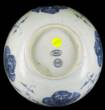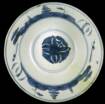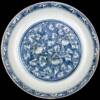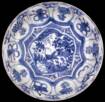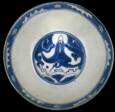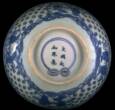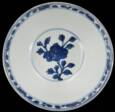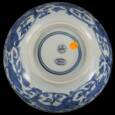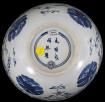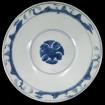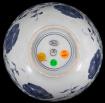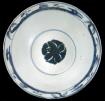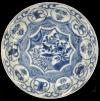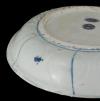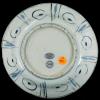Ser. No. W-1683
A small kraak dish from the Wanli (c.1625) shipwreck. This dish is more than likely made at the Guangyinge kiln complex (Jingdezhen, China) where we have located production waster similar to this dish. The main decorative motifs are Chinese auspicious symbols wishing for a healthy and long life. The dish is totally intact with good glaze and soft decoration and limited 'tender edges'. The plate will be delivered with a Certificate of Authenticity.
Size: 15 cm dia
Tender edges , or as the Japanese more graphically described it, 'moth-eaten' edges is a technical fault in early 17th century porcelain. This effect is seen when the glaze breaks off in patches along sharp edges in a rather irregular manner and particularly common on the rims of bowls, dishes and plates. The cause is complex, but is mainly due to the physical properties of the raw materials and the varying surface tensions of the ingredients of the body and glaze. The fault was overcome in the later part of the 17th century when the potters adjusted the proportions of raw materials.
Tender edges is a commonly acceptable factor for authenticity and should not be mended, as a principle, as it adds to the provenance of the ware. The 'faking' of 'tender edges' is not possible as the edges of the broken off pieces cannot be made as sharp at the original.
Ming dynasty porcelain, Chinese pottery from the Wanli shipwreck, kraak porcelain, kraak bowls, plates and dishes. Porcelain dish and porcelain marks and reign marks. All legally excavated by ourselves
REST ASSURED OF PROPER AUTHENTICITY
When ordering from these pages you are dealing directly with a team of dedicated researchers that excavated, recovered and researched every single artifact offered for sale. We encourage you to contact our Sten Sjostrand with any questions which you may have.
OUR GUARANTEE:
If you are not satisfied with our artifacts, delivery service or; if you obtain an expert opinion that a delivered item is not of the age stated by us, just return it and we will issue full refund.
Sten has spent more than forty years in Southeast Asia designing and engineering various marine structures. His interest in Asia's pottery and porcelain eventually lead to his search and excavation of numbers of ancient shipwrecks. As a championship sailor Sten has extensive knowledge and interest in ancient maritime trade, ships designs and construction. It is these interests and gained knowledge that is the base for all his books and extensive lecturing.
Sten's company; Nanhai Marine Archaeology Sdn. Bhd. works with Malaysia's Department of Museums and Antiquities and can therefore offer legally excavated artifacts from these shipwrecks.
In addition to working with recovering artifacts, Sten has located number of ancient kiln sites in Thailand and in China were his shipwreck ceramics was made centuries ago. He is therefore able to offer absolute provenance on all ceramics sold via Nanhai Marine Archaeology Sdn. Bhd. and, with good conscience sign every Certificate of Authenticity supplied with the artifacts.
The maritime archaeology of Sten Sjostrand has led to major advances in the study of Asian trade and trade ceramics in Southeast Asia. His meticulous documentation of a series of nine shipwrecks from the 11th to 19th centuries reveals the early dominance of Chinese trade ceramics, a subsequent loss of the Chinese monopoly in the late 14th century when Southeast Asian ceramics entered the market, the basic parameters of the Ming gap shortages of the 14th-15th centuries, and a resurgence of Chinese wares in the 16th and 17th centuries. Just as important, Sjostrand freely shares the information from his discoveries. Researchers are welcome at his headquarters where he documents his finds and patiently answers the queries of others. A lifetime’s experience with the sea and sailing allows Sjostrand to bring new understanding to ancient ship construction, and his voluminous reading allows him to set the ships and their cargoes in historical perspective.
Dr. Roxanna M. Brown
Director.
Southeast Asian Ceramics Museum
Bangkok University, Rangsit campus
Pathum Thani 12120, Thailand
Ser. No. W-3811
A small bowl showing the famous "boatman" motif. The decoration is well executed of soft cobalt blue tones. The bowl is intact except for a fine (hard to see) and now mended hairline. Despite this, the resonance sound is very high when tapped. There are no ''tender edges' along the rim. The base feature the six character (apocryphal) reign mark of emperor Chenghua. The bowl will be delivered with a Certificate of Authenticity
Size: 9cm diameter.
Price: USD. 490.00
Ser. No. W-2430
The main motif in this kraak plate is a duck on a rock below a flower arrangement. This theme represent the famous 'spring time and longevity' motif which was popular during the Ming dynasty The plate is totally intact with well executed, crispy and high contrasty decorations. When tapped, the plate gives a very high pitch resonance sound which suggest good quality clay and good workmanship.The plate will be delivered with a Certificate of Authenticity
Size: 20.5 cm in diameter
Ser. No. W-250 A RARE BUTTERFLY BOWL
In the cargo on the Wanli shipwreck, there were very few bowls of this type. The bowl is decorated with butterflies among flower arrangements. The symbolism of the butterfly is long life, beauty and elegance and represents yang energy of yin - yang The bowl is of good quality, intact except for a small, hard to see, rim fill. The resonance is very high pitch sound. The bowl shows high contrast decoration which is well executed. There are some marine growth in the base. The rim is smooth and free from 'tender edges'. Delivered with a Certificate of Authenticity
Size: 12.5 cm diameter.
Shipping weight: 0.55 kilo
Ser. No. W-5899
This totally intact fungus bowl belongs to the 'best available' group of ceramic artifacts from the Wanli shipwreck site. It shows a series of fungus liangcao motifs. This plant is a rare Chinese herbal medicine reputed as "elixir of life". The bowl is totally intact with little 'tender edges' along the rim. The glaze is in a very good glossy condition and the resonance of the bowl is very high pitch. The base is glazed but without any markings. Delivered with a Certificate of Authenticity
Size: 14.5 cm diameter.
 | ||||
THE ONLY PLACE WHERE YOU CAN BE SURE TO BUY GENUINE ANTIQUES
Nanhai Marine Archaeology Sdn. Bhd. was incorporated on the recommendation of the Malaysian authorities. This was done in order to formalize and to expand on the company’s researcher’s extensive knowledge of Asia’s ceramic developments and maritime trade.
The company’s researchers have been engaged in the search for historical shipwrecks for more than two decades and another decade researching maritime trade. Most of this work is concentrated to the South China Sea, a virtual highway for ancient shipping linking China to India, the Middle East and Southeast Asia in an extensive maritime trade system. This ancient trade started sometime around the 4th century and lasted well into the 19th century.
Following a successful shipwreck discovery, the company obtain a government permit to excavate the wreckage, and then carry out detailed marine archaeological procedures in recovering the artifacts, mapping the ship's remains and securing other data for future research. After each concluded project and following conservation of recovered artifacts, we search for and pinpoint ruined kiln sites and compare its wasters with the recovered ceramics until we are satisfied we located the place in which the shipwreck pottery was made centuries earlier.
As such we have precisely located a kiln sites in Sisatchanalai, northern Thailand in which our Royal Nanhai and the Nanyang shipwreck celadon ware was made around AD. 1380-1460. (See videos on: http://www.ming-wrecks.com/photopage.html ) Other kilns was located in Sukhothai where production wasters matched the fish and flower plates found on the Turiang and the Longquan shipwreck. These unique underglaze decorated wares was made at those exact kilns 600 years earlier! Our latest shipwreck cargo; The Wanli Shipwreck, of Chinese blue and white porcelain, was likewise pinpointed to the Guangyinge kiln site in Jingdezhen, China. (See video on: http://www.ming-wrecks.com/photopage.html )
Our arrangement with the Malaysian authorities is such that we finance all operations and train young Malaysian nationals (on our initiative) in maritime archaeology and related research. After giving all unique and single artifacts and thirty percent of all recovered items to the National Museum (and assisting with exhibitions of artifacts from each project) we are allowed to sell our portion of the recovery to finance future projects. The findings from ongoing research and the compilation of reports, books and catalogues are available on these pages as well as on a separate Internet site: http://www.maritimeasia.ws
Due to the unquestionable authenticity and precisely dated shipwreck pottery, many International Museums now display our shipwreck pieces as reference material.
The artifacts sold on this website are therefore legally and properly excavated and can be supplied with an export permit from the Department of Museum in Malaysia should this be required. This unique working arrangement makes us one of the few Internet sellers that sell from own excavation and deliver a meaningful Certificate of Authenticity with every artifact issued with a serial number.
So, if you are interested to purchase some of our Antique porcelain, old time pottery or other shipwreck artifacts from the Song dynasty, Ming porcelain or Chinese blue and white porcelain or the famous Yixing teapots, you can rest assured that every piece is excavated through proper archaeology by our own staff. We do not sell anything that is not excavated by ourselves or properly recorded and researched before offered for sale so every piece comes with the “Best possible provenance”
WE ENCOURAGE YOU TO EMAIL OUR PRINCIPAL RESEARCHER; Sten Sjostrand SHOULD YOU HAVE ANY QUESTIONS ABOUT YOUR POSSIBLE PURCHASE
Ser. No. W-588
A good quality, totally intact, wine grape bowl with contrasty decoration. The bowl is very delicate and thinly potted. When tapped, the bowl gives away a high pitch resonance sound which suggest very high firing temperature. There are no 'tender edges'. Glaze surface is satin. The bowl will be delivered with a Certificate of Authenticity
Size: 9 cm diameter.
Ser. No. W-3238
This intact kraak plate shows the typical 'spring motif' represented by a grasshopper below a flower arrangement. These motifs, together, carry hope for a long happy life. The plate show very good glaze condition and high contract in the decorations. There are no 'tender edges' along the rim. There is however an original rim dent (from the date of manufacturing) at about 10 o'clock, and some original dry crack on the reverse. There is also a now mended very fine (near impossible to see) hairline in the rim. The resonance of the plate is however fully restored and now gives a high pitch tone when tapped. Delivered with a Certificate of Authenticity
Size: 21cm diameter.
All artifacts on this page are described in the catalogue: "The Wanli Shipwreck and its Ceramic Cargo" click here view
Archaeologists from the Archaeology Department at the Palace Museum in Beijing is currently excavating the ancient kiln sites at Guangyinge, Jingdezhen, China. The budget for the excavations is provided for three years of work. It was on this site that our own Sten Sjostrand discovered production wasters (in March 2005*) which were identical to those porcelain pieces found on the Wanli (1625) shipwreck in Malaysian waters.
Mr. Wang Guangyao, Research fellow at the Palace Museum heads the excavations and confirm in discussions with Mr. Sjostrand that the museum's archaeologists (by November -07) had discovered three different kilns and that many of the shards found in those kilns are identical to those from the shipwreck.
On receiving the Wanli shipwreck catalogue: The Wanli Shipwreck and its Ceramic Cargo, Mr. Wang commented:
"Dear Mr.Sten Sjostrand
Thank you for your book, its contents is extremely important and very helpful to my research.
I am look forward to meet you again in the spring of 2008 (at Guangyinge) and exchange our viewpoint about the excavation of Guanyinge site".
* In August 2005 when Sten returned to the site, (picture on the right) a China Central TV film crew
was recording his visit and the shards then discovered. A copy of this DVD video
is supplied, free of charge, with every purchase of artifacts.
Ser. No. W-6942
This kraak dish is totally intact and feature a bird on a rock. By adding a flower arrangement to the motif, the decorator conveyed the famous 'spring time and longevity' motif. This motif was popular during the Ming dynasty. The decoration on this plate is well executed in a soft tone on a contrasty, white, background. The rim of the plate is smooth and relatively free from 'tender edges'. Glaze surface is glossy, thick, and is one of the best seem in the Wanli (AD. 1625) shipwreck cargo. Resonance of the plate is very good which suggest it was high fired and made from good quality clay. Sand grits seen attached to the foot ring is clear evidence of a typical Ming dynasty firing method and adds provenance to the dish. The dish will be delivered with a Certificate of Authenticity
Size: 20.5 cm diameter.
For a detailed report about the Wanli (1625) shipwreck and its ceramic cargo, please visit our: The Wanli Shipwreck pages
Ser. No. W-6489
Fully intact landscape bowl of good quality. The glaze is satin and the motif contrasty and highly stylized. There are no 'tender edges' on the rim. glaze surface is thick and glossy. The resonance sound when tapped is very high pitch.
The characters in the base are written as "Ya" which means 'Elegant' or 'Refined'.
To be delivered with a Certificate of Authenticity
Size: 12 cm diameter
Ser. No. W-6070
A very nice kraak dish with rounded sides. The dish was recovered from the Wanli C.1625 shipwreck) The main motif is a grasshopper on a rock besides a flower arrangement. This represent the famous 'spring time and longevity' motif which was popular during the Ming dynasty. The wise grasshopper will remind us that we possess the strength and courage to take action and make bold decisions whenever necessary in order to get what we want in life.The dish is intact with almost no 'tender edges' . It has a warm and smooth feeling and good, glossy, glaze surface. The dish will be delivered with a Certificate of Authenticity
Size: 21 cm diameter
Ser. No. W-1457
A RARE peony dish painted in reserve where the background, rather than the motif, is painted in blue. The painting is crispy blue and well executed. The peony flower signifies richness, opulence, beauty, honor and high social status and is the symbol of spring. It is also used as a metaphor for female beauty and reproduction. The glaze covering is very good. A fine hairline is mended and the dish now produce a high pitch sound when tapped. The plate will be delivered with a Certificate of Authenticity
Size: 21.5 cm diameter.
Kraak dishes from the Wanli (c.1625) shipwreck. These dishes are likely to have been made at the Guanyinge kiln complex, Jingdezhen, China, where similar production waster has been found. The main decorative motif; the bird on a rock, the flower arrangement and being surrounded by various emblems on the cavetto, represent the popular 'spring time and longevity' motif which was popular during the Ming dynasty. The motif of a lantern and tassel represents joy and festivities to the Chinese. A lantern is often given as a auspicious gift at weddings and play an important role in social and religious life. Both dishes has a small and shallow rim fill which is very hard to see. W-1691, in addition show a mended split which is very hard to see. To be delivered together with a Certificate of Authenticity
Ser. No. W-5093
A totally intact kraak plate with nice decoration. The bird on the rock below a flower arrangement symbolizes the 'spring time and longevity' which was a popular motif during the Ming dynasty. The plate is in good condition but there is a small dry crack in the center of the well. Resonance is high pitch which suggest high firing temperature and good quality clay. The few sand grits on the foot ring adds evidence of Ming dynasty firing techniques.Glaze surface is satin .Overall, this is one of the best kraak plate recovered from the Wanli (AD. 1625) shipwreck site. The rim is almost free from 'tender edges' The plate will be delivered with a Certificate of Authenticity
Size: 21.5 cm diameter.
Large Character Bowl from the Ming dynasty
This RARE and much south after character type of bowl depicts Shou Lao, the God of longevity, riding a crane above crested waves in the well. The exterior decoration feature four medallions, each depicting two of the Eight Immortals, surrounded by repeated shou (longevity) characters. This repeated use of the the shou character is known as Bai Shou Tu in Chinese, meaning the 'Picture of One Hundred shou characters' and is very common in Chinese traditional work of art. These bowls are traditionally an excellent gift as they provide wishes for long life. The Eight Immortals are the favorite pantheon in Daoism.
Character bowl W-4995 appear intact and free from repairs but has a very fine, short hairline. This hairline has been mended and cannot be seen from the outside. WIth the mending, the resonance fully restored. The decoration is perfectly executed and in contrasty cobalt colors. The base is glazed and show the (apocryphal) reign mark of emperor Chenghua whom ruled China between 1464 - 1487. The bowl will be delivered with a Certificate of Authenticity
Ser. No. W-5898
Size: 21.5 cm diameter
Ser. No. W-4995
Size: 22 cm in diamter
Lion dog bowl from the Ming dynasty
This lion dog bowl is from the best available group and feature one of the best-known Ming dynast motifs: 'Lion piecing through peony scrolls'. The cobalt blue decoration is rich, contrasty, well-rendered and stands out in contrast to the white background. The bowl is totally intact except for some very shallow rim fills that are hard to see. The resonance sound when tapping the bowl is a very high pitch sound which suggest good quality clay and high firing temperature. There is only one short section where there is 'tender edges' along the rim. There is an overall nice, smooth and warm feeling all over the bowl. To be delivered with a Certificate of Authenticity.
Large Flower Bowls from the Ming dynasty
These large flower bowls are hardly ever seen in the antique markets. They show four unusual floral roundels separated by a lotus scroll. The interior is finished with another floral roundel in the well and a high border with palm trees, pagoda, landscape and small boat motifs. The bowls sometimes shows the apocryphal reign mark of emperor Chenghua (1464 - 1487) and sometimes the blue circles only. Very RARE is the use of bi-style foot-ring which, due to its width never include reign marks.
The motifs on flower bowl W-4139 are well executed and in high contrast. Inner border is unusually high and nicely rendered. The bowl is intact except for a mended and hard-to-see hairline. Despite this, the bowl and give a very high resonance sound when tapped. The base is glazed.
The bowl will be delivered with a Certificate of Authenticity. The diameter of the bowl is 22 cm.
We are PayPal Verified
for safe Online payments
To understand and to appreciate the basics about Chinese art-history as applied to this type of Ceramics; click here
Throughout the history of art in China, decorative motifs were applied not exclusively for their aesthetic value but also their symbolic implications. Daoism, the main religious philosophy of the time, dwelled on issues of harmony of man and the universe. Images of nature were widely featured during this period.
The natural world is celebrated with images of peonies signifying spring, the lotus for summer, the Chrysanthemum for autumn and Prunus for winter. Landscapes depicted on porcelain are inhabited by deer, birds, butterflies and crickets. There is also a fondness for highly symbolic images of dragons, phoenix and cranes.
Favorites in the Daoist pantheon are the Eight Immortals. The eight-paneled kraak plates (with scalloped flat rims) are decorated with images of motifs traditionally associated with the Immortals - fans, castanets, fly whisk and the double gourd bottle. Buddhist symbols such as sacred scrolls, the Swastika and the Artemisia leaf are also featured.
About apocryphal marks:
The 17 th century Portuguese and Dutch buyers required porcelain wares to have markings of some kind in the base. A letter from the Dutch headquarters in Batavia to their office in Taiwan request in 1610: "It should be seen to that all these afore-noted kinds of porcelain have under the bottom a blue seal, for about this they (the buyers) are very particular."
Since the decorators were not allowed to paint the present emperors reign mark on export wares, they painted the mark of an previous emperor. Such marks are very common and always indicating and earlier production time. The present emperors' reign mark could only be applied to imperial wares ordered by the palace
Ser. No. W-7490
Size: 14.5cm dia
Ser. No. W-1691
Size: 14.5cm dia
Ser. No. W-4139
Ser. No. W-4274
Flower bowl W-4274 is totally intact and from our "best available quality" group.The rendering is well made in contrasty cobalt oxide. The resonance sound from the bowl when tapped is a very high pitch sound which suggest high firing temperature, good quality clay and quality workmanship. There are some 'tender edges' along the rim which is a technicality that belong to the period and add provenance to the bowl. The base show the six character apocryphal mark: "Made during the Chenghua (1464-1487) reign of the great Ming dynasty". The bowl will be delivered with a Certificate of Authenticity. The diameter of the bowl is 22 cm.
 | ||||
Click here to add text.
Ser. No. W-6261
Totally intact and very good quality squirrel bowl. The main decorative motifs on this bowl is a squirrel among grapes and grape foliage. To the Chinese the combined meaning of the motives is happiness for many generations to come, i.e. many grandchildren. The squirrel is better rendered than on other bowls in the Wanli cargo. The cobalt blue decoration is in high contrast and glaze condition is very good. The base show a apocryphal four character (Chenghua Nian Zao) reign mark of emperor Chenghua (1464-1487). There are no 'tender edges'. The bowl will be delivered with a Certificate of Authenticity
Size: 12 cm diameter
Price: USD 1,290.00
We deal with Ming dynasty and Ming dynasty porcelain from the wanli shipwreck that also contain Chinese pottery, porcelain bowl, porcelain marks and reign marks and many kraak porcelain, kraak bowl, kraak plate. All work is done legally by Sten Sjostrand from Nanhai Marine Archaeology.
Ser. No. W-1017
Flower bowl W-1017 is intact and show contrasty painting in high contrast cobalt oxide. The resonance sound when tapped is very high pitch which suggest good quality clay and good workman ship. There are however two fine (now medned) hairlnes which are near impossible to see. The rim is almost totally free from 'tender edges' To be delivered with a Certificate of Authenticity. The diameter of the bowl is 22 cm.
The medallion on this plate shows wild ducks which signifies blessings for a fruitful marriage, since a marriage proposal was made by a man sending a duck to a woman's family as a present. Acceptance of the duck meant acceptance of the proposal. The lotus, shown in different stages of growth, symbolizes purity and abundant offspring's. The rim of the plate is smooth and free from tender edges'. There is however a fine, now mended hairline and some smaller fill-in at the foot-ring. Glaze surface is satin. The plate will be delivered with a Certificate of Authenticity
Size: 21 cm diameter.
Ser. No. W-4806
This totally intact fungus bowl belongs to the 'best available' group of ceramic artifacts from the Wanli shipwreck site. It shows a series of fungus liangcao motifs. This plant is a rare Chinese herbal medicine reputed as "elixir of life". The bowl is totally intact with little 'tender edges' along the rim. The glaze is in a good glossy/satin condition and the resonance of the bowl is very high pitch. The base is glazed but without any markings. Delivered with a Certificate of Authenticity
Size: 14.5 cm diameter.
Ser. No. W-578
Scholar bowl from the Wanli C.1625 shipwreck. The exterior shows figures in a mountainous landscape. Superb rendering, in high contrast, shows great variation and masterly use of cobalt tones. The bowl provide a high pitch sound when tapped, despite a short, shallow rim fill. This fill is done professionally using museum grade materials and now impossible to see.
The base show the six character apocryphal mark: "Made during the Chenghua (1464-1487) reign of the great Ming dynasty". To be delivered with a Certificate of Authenticity
Size: 14 cm diameter.
SPECIAL OFFER !
This large kraak plate (29 cm in diameter) is also from the Ming dynasty Wanli shipwreck which sunk about AD. 1625. The plate shows well rendered and contrasty motifs which include ducks on a rock below a lotus arrangement. These motifs express wishes for a long life which, to the Chinese, means: chum gung Chang shout referring to the theme: 'spring time and longevity'.
All this together connotes blessings for vibrant youth, healthiness and a long life.
The wild ducks signifies blessings for a fruitful marriage, since a marriage proposal was made by a man sending a duck to a woman's family as a present. Acceptance of the duck meant acceptance of the proposal. The lotus, shown in different stages of growth, symbolizes purity and abundant offspring's.
The rim is smooth and free from 'tender edges' which add to the plate's overall pleasant and 'warm' feeling. There is a shallow rim repair as indicated by the gray line shown in the pictures. This repair is done by our experienced restorer, using best quality museum grade material and made to blend with other parts of the rim and therefore hard to see.


















